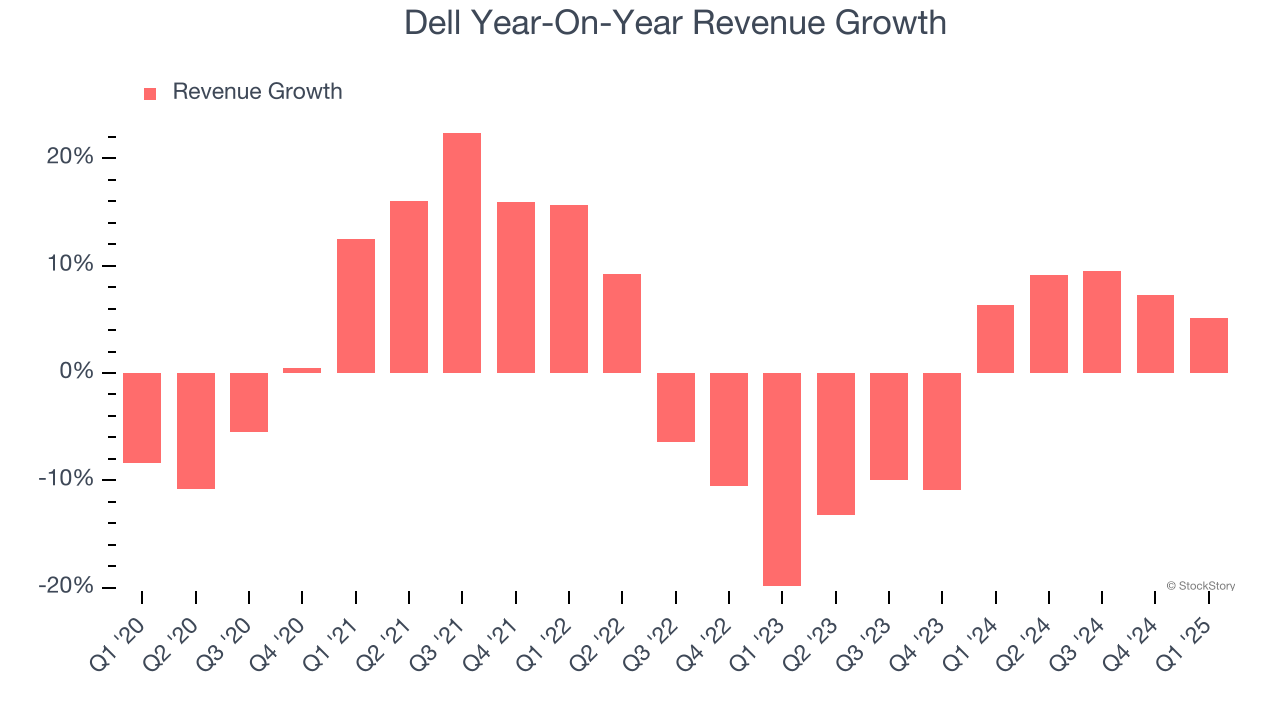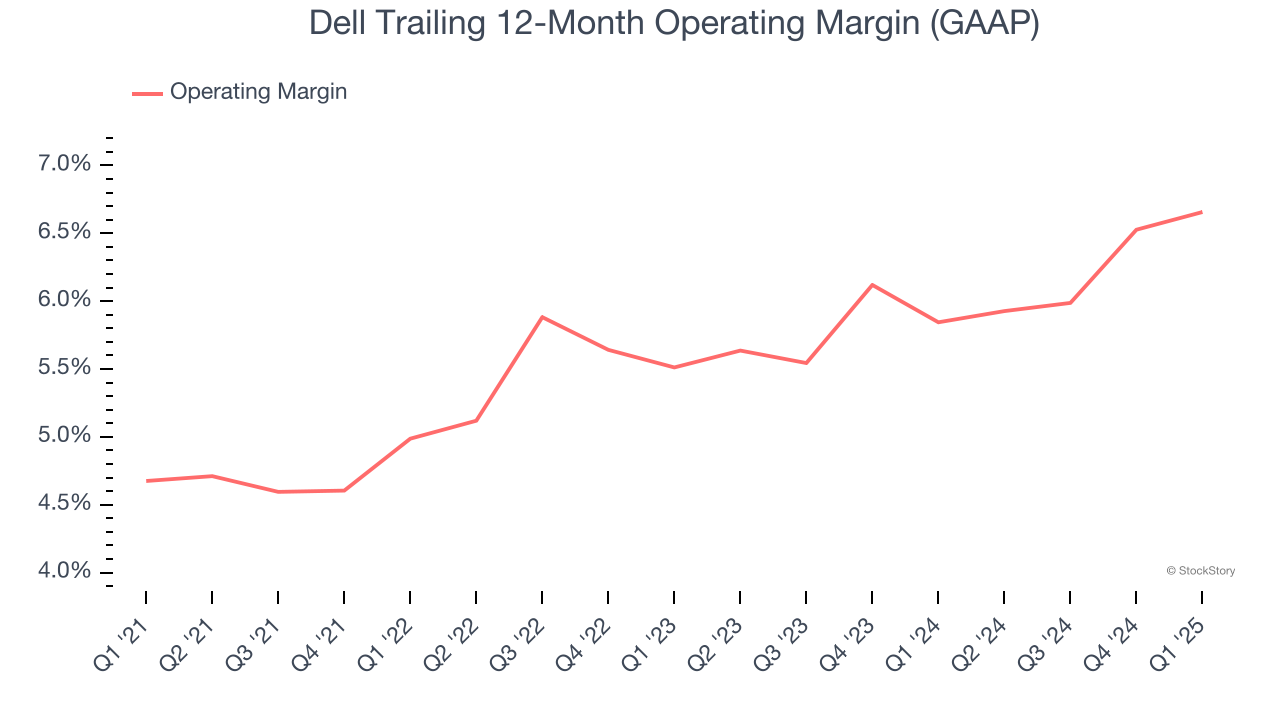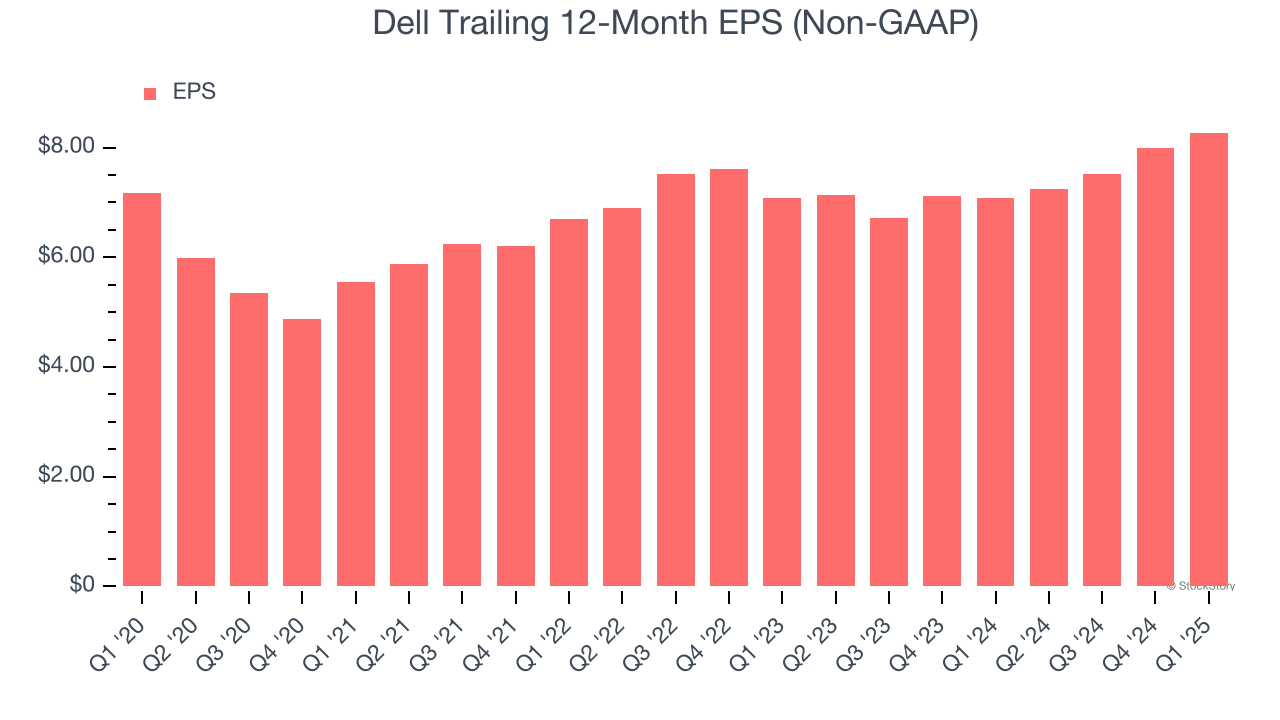
Computer hardware and IT solutions company Dell (NYSE: DELL) announced better-than-expected revenue in Q1 CY2025, with sales up 5.1% year on year to $23.38 billion. On top of that, next quarter’s revenue guidance ($29 billion at the midpoint) was surprisingly good and 15.8% above what analysts were expecting. Its non-GAAP profit of $1.55 per share was 8.4% below analysts’ consensus estimates.
Is now the time to buy Dell? Find out by accessing our full research report, it’s free.
Dell (DELL) Q1 CY2025 Highlights:
- Revenue: $23.38 billion vs analyst estimates of $23.13 billion (5.1% year-on-year growth, 1.1% beat)
- Adjusted EPS: $1.55 vs analyst expectations of $1.69 (8.4% miss)
- Adjusted EBITDA: $1.29 billion vs analyst estimates of $2.45 billion (5.5% margin, 47.3% miss)
- Revenue Guidance for the full year is $103 billion at the midpoint, roughly in line with what analysts were expecting
- Adjusted EPS guidance for the full year is $7.99 at the midpoint, missing analyst estimates by 12.9%
- Operating Margin: 5%, in line with the same quarter last year
- Free Cash Flow Margin: 9.5%, up from 2.1% in the same quarter last year
- Market Capitalization: $77.76 billion
Company Overview
Founded by Michael Dell in his University of Texas dorm room in 1984 with just $1,000, Dell Technologies (NYSE: DELL) provides hardware, software, and services that help organizations build their IT infrastructure, manage cloud environments, and enable digital transformation.
Sales Growth
A company’s long-term performance is an indicator of its overall quality. Any business can have short-term success, but a top-tier one grows for years.
With $96.7 billion in revenue over the past 12 months, Dell is a behemoth in the business services sector and benefits from economies of scale, giving it an edge in distribution. This also enables it to gain more leverage on its fixed costs than smaller competitors and the flexibility to offer lower prices. However, its scale is a double-edged sword because it’s challenging to maintain high growth rates when you’ve already captured a large portion of the addressable market. To expand meaningfully, Dell likely needs to tweak its prices, innovate with new offerings, or enter new markets.
As you can see below, Dell’s 1.4% annualized revenue growth over the last five years was sluggish. This shows it failed to generate demand in any major way and is a rough starting point for our analysis.

We at StockStory place the most emphasis on long-term growth, but within business services, a half-decade historical view may miss recent innovations or disruptive industry trends. Dell’s recent performance shows its demand has slowed as its revenue was flat over the last two years. 
This quarter, Dell reported year-on-year revenue growth of 5.1%, and its $23.38 billion of revenue exceeded Wall Street’s estimates by 1.1%. Company management is currently guiding for a 15.9% year-on-year increase in sales next quarter.
Looking further ahead, sell-side analysts expect revenue to grow 8% over the next 12 months, an improvement versus the last two years. This projection is particularly healthy for a company of its scale and implies its newer products and services will spur better top-line performance.
Software is eating the world and there is virtually no industry left that has been untouched by it. That drives increasing demand for tools helping software developers do their jobs, whether it be monitoring critical cloud infrastructure, integrating audio and video functionality, or ensuring smooth content streaming. Click here to access a free report on our 3 favorite stocks to play this generational megatrend.
Operating Margin
Operating margin is a key measure of profitability. Think of it as net income - the bottom line - excluding the impact of taxes and interest on debt, which are less connected to business fundamentals.
Dell was profitable over the last five years but held back by its large cost base. Its average operating margin of 5.5% was weak for a business services business.
On the plus side, Dell’s operating margin rose by 2 percentage points over the last five years, as its sales growth gave it operating leverage.

This quarter, Dell generated an operating margin profit margin of 5%, in line with the same quarter last year. This indicates the company’s overall cost structure has been relatively stable.
Earnings Per Share
Revenue trends explain a company’s historical growth, but the long-term change in earnings per share (EPS) points to the profitability of that growth – for example, a company could inflate its sales through excessive spending on advertising and promotions.
Dell’s EPS grew at a weak 2.9% compounded annual growth rate over the last five years. On the bright side, this performance was better than its 1.4% annualized revenue growth and tells us the company became more profitable on a per-share basis as it expanded.

Diving into the nuances of Dell’s earnings can give us a better understanding of its performance. As we mentioned earlier, Dell’s operating margin was flat this quarter but expanded by 2 percentage points over the last five years. On top of that, its share count shrank by 6.8%. These are positive signs for shareholders because improving profitability and share buybacks turbocharge EPS growth relative to revenue growth. 
In Q1, Dell reported EPS at $1.55, up from $1.27 in the same quarter last year. Despite growing year on year, this print missed analysts’ estimates. Over the next 12 months, Wall Street expects Dell’s full-year EPS of $8.27 to grow 16.7%.
Key Takeaways from Dell’s Q1 Results
We were impressed by Dell’s optimistic revenue guidance for next quarter, which blew past analysts’ expectations. We were also happy its revenue narrowly outperformed Wall Street’s estimates. On the other hand, its full-year EPS guidance missed and its operating income fell short of Wall Street’s estimates. Overall, this quarter was mixed, but it seems like expectations were fairly low. The stock traded up 5.2% to $119.49 immediately following the results.
Is Dell an attractive investment opportunity at the current price? We think that the latest quarter is only one piece of the longer-term business quality puzzle. Quality, when combined with valuation, can help determine if the stock is a buy. We cover that in our actionable full research report which you can read here, it’s free.







